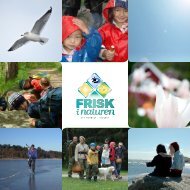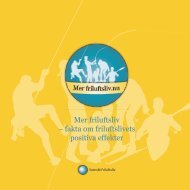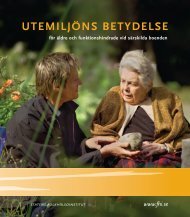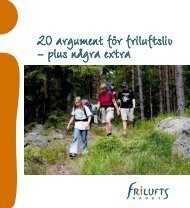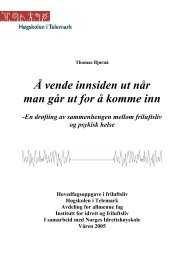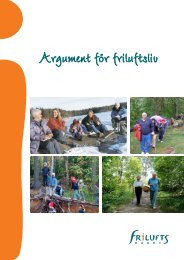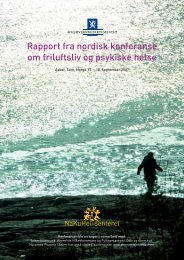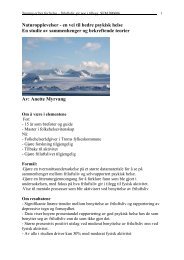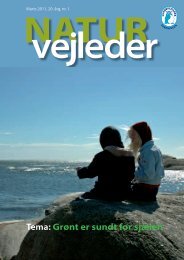Green Care: A Conceptual Framework - Frisk i naturen
Green Care: A Conceptual Framework - Frisk i naturen
Green Care: A Conceptual Framework - Frisk i naturen
Create successful ePaper yourself
Turn your PDF publications into a flip-book with our unique Google optimized e-Paper software.
Table 3.4: Examples of ‘natural’ dimensions in green care<br />
n Sense of connectedness with nature, possibly fulfilling a spiritual<br />
need<br />
n View of nature as inherently peaceful and exerting a calming effect<br />
n Sense of well-being through the belief that nature and fresh air are<br />
inherently healthy<br />
n ‘Fascination’ with nature i.e. being able to engage with it without<br />
great effort<br />
n Opportunity for nurturing plants and animals and the satisfaction and<br />
fulfilment that ensues<br />
n Protecting nature – fulfilment of the desire to protect the environment<br />
from damage from pesticides and other chemicals<br />
n Working together with nature in order to maintain or improve it<br />
n Engagement with a dynamic system i.e. through changing seasons<br />
and weather<br />
n Being governed by the needs of the environment through the<br />
need to plant or harvest at appropriate times – the environment as<br />
demanding of labour<br />
3.4 The therapist (or facilitator) in green care<br />
The role of therapists in green care varies with the purpose of the therapy,<br />
and the setting. This is well exemplified in equine assisted therapies. A<br />
particularly specific example is hippotherapy, where the movement of the<br />
horse and the patient-rider’s muscular response to it help people who have<br />
suffered a stroke or have a neurological deficit to better regain muscular coordination<br />
(see, for example, McGibbon et al, 2009). The therapist’s role is<br />
to accomplish that safely and effectively.<br />
A very different but equally specific therapist role is in equine<br />
psychotherapy (see Karol, 2007). This need not involve mounting or<br />
riding a horse, but has as its task the establishment and facilitation of<br />
a relationship between the patient and the horse, which is the focus of<br />
further therapy. Through this process, emotional difficulties will be directly<br />
expressed (in how the patient relates to the horse), or apparent to the trained<br />
therapist through the reactions of the horse. The therapist may allow this<br />
to emerge naturally, or make interpretations to help the patient become<br />
32 <strong>Green</strong> <strong>Care</strong>: A <strong>Conceptual</strong> <strong>Framework</strong>



